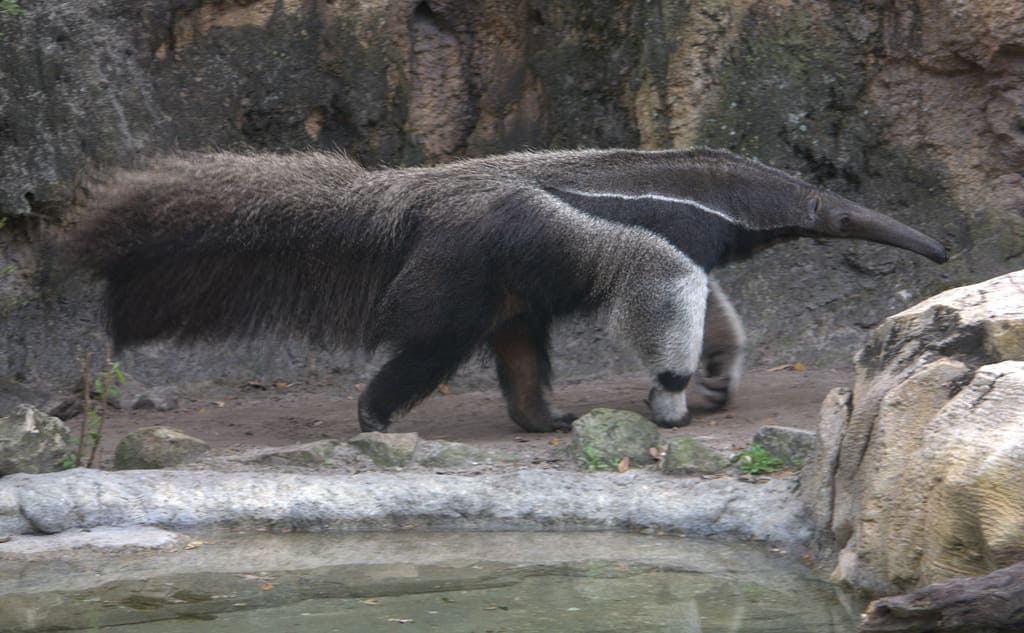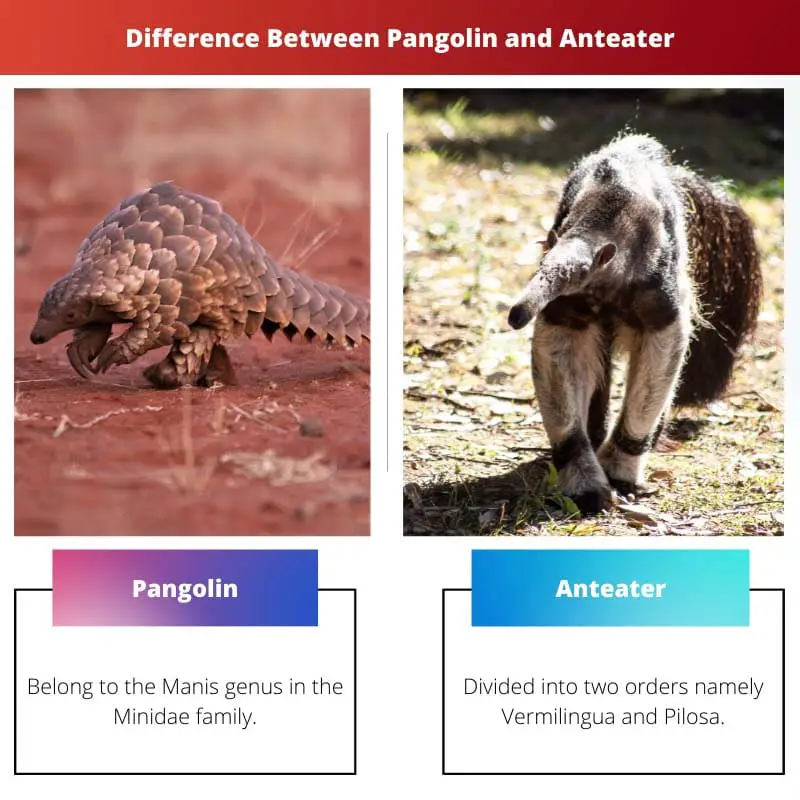Pangolins are still the most traded species on the planet, with an estimated population of barely one million.
Although anteaters are not currently endangered, habitat loss and poaching have resulted in the extinction of a large portion of their population.
Although the pangolin and the anteater have many similarities, they also have several distinctions. Poaching for the illicit wildlife trade and habitat degradation have made these amazing animals one of the world’s most endangered mammals.
Key Takeaways
- Pangolins are scaly mammals in Asia and Africa, while anteaters are toothless mammals in Central and South America.
- Pangolins have protective scales, while anteaters have long tongues for catching insects.
- Pangolins are endangered due to hunting and habitat loss, while anteaters are not considered endangered.
Pangolin vs Anteater
Pangolins are small, mammalian animals that are covered in scales with long, sticky tongues that they use to catch ants and termites to feed. Anteaters are found only in the Americas and are known for their long, slender snouts and tongues that they use to feed on ants and termites.

Pangolins are coated in a distinctive pattern of strong, overlapping scales. These creatures have a long, sticky tongues that they use to devour ants and termites, and they can swiftly curl themselves into a tight ball if they feel threatened.
Pangolins are found in Asia and Africa in eight different species.
Anteaters are edentate creatures, meaning they don’t have teeth. On the other hand, their large tongues are more than enough to consume the 35,000 ants and termites they ingest daily.
The giant anteater is the biggest of the four anteater species, measuring eight feet from the tip of its nose to the end of its tail.
Comparison Table
| Parameters of Comparison | Pangolin | Anteater |
|---|---|---|
| Individual species | Belong to the Manis genus in the Minidae family | divided into two orders namely Vermilingua and Pilosa |
| Habitat | Found in savannah grassland, tropical and flooded forests. | Found in rainforests, savannas, dry tropical forests, and rainforests. |
| Distribution | Found all throughout Asia and in the Sahara desert to the south | Found in southern Mexico, Central America, Uruguay, and eastern Brazil. |
| Fur | No fur is present. | Body is wholely covered with long fur. |
| Scales | Scales are present all over the body. | No scales are present. |
What is Pangolin?
These rare insect-eating animals have robust overlapping scales and may be found across Asia and south of the Sahara desert.
Pangolins are divided into eight species, all of which belong to the genus Manis, which is part of the Minidae family. Within the order Pholidota, this is the single-family.
Chinese pangolins, Sunda pangolins, Pawalan pangolins, and Indian pangolins are all Asian pangolin species.
White-bellied pangolins, Giant pangolins, Ground pangolins, and black-bellied pangolins are all African pangolin species. Pangolins range in size from 1.6 to 33 kilograms, having overlapping keratin scales covering their whole body.
On the other hand, the underside lacks scales and is covered with scanty hair. The sole distinction between Asian pangolins and African pangolins is that Asian pangolins have bristles in between their scales.
Pangolins have sticky tongues that are ideal for sucking up ants, toothless jaws, and conical heads.
Their tongues are attached around the final pair of ribs and pelvis, and when fully extended, they can be the length of the animal’s body and head. They have sturdy limbs with five toes on each paw, which are suitable for digging.
Three curved and long claws on their forefeet are used to dig sleeping and nesting tunnels as well as smash termite nests.
They can also swim and climb, with certain species excelling at both. They are extremely delicate, nocturnal, and solitary creatures.

What is Anteater?
This mammal species feed mostly on ants and termites and may be found in southeastern Mexico, Central America, Uruguay, and eastern Brazil.
They belong to the Vermilingua and Pilosa orders and are closely related to sloths. The extract species include the giant anteater, northern tamandua, silky anteater, and southern tamandua.
They have a thin tongue and an extended snout with tube-shaped jaws, which they use to rip and open termite mounds as a defence strategy. They also have a thick coat of fur that protects them from insects.
Even though they all eat little insects, each species has its tastes. Tiny species graze on arboreal insects on small branches, whereas giant species may enter terrestrial insect nets.
Thousands of tiny hooks called filiform papillae cover the tongue of insects to keep them together. Anteaters may be found in a variety of environments, including rainforests, savannas, dry tropical forests, and rainforests.
They are solitary creatures with a keen sense of smell but limited vision.
The anteater has the lowest body temperature of any land-dwelling animal, at around 89.6 degrees Fahrenheit.
This is most likely because their major dietary staple has little to no nutritional or calorie value despite the huge quantities consumed.

Main Differences Between Pangolin and Anteater
- Pangolins belong to the Manis genus in the Minidae family. Anteaters, on the other hand, are divided into two orders: Vermilingua and Pilosa.
- Pangolins may be found in savannah grassland, tropical and flooded forests, as well as tropical environments that have been cleared and developed. Conversely, Anteaters live in rainforests, savannas, dry tropical forests, and rainforests.
- Pangolins may be found throughout Asia and in the Sahara desert to the south. Conversely, Anteaters are found in southern Mexico, Central America, Uruguay, and eastern Brazil.
- Unlike pangolins with thin hair on their undersides, anteaters have lengthy fur that defends them from insect assaults.
- Pangolins have scales on their bodies, but anteaters do not.

- https://link.springer.com/article/10.1007/s10577-009-9027-0
- https://www.cambridge.org/core/journals/journal-of-zoology/article/abs/morphology-evolution-and-function-of-feeding-in-the-giant-anteater-myrmecophaga-tridactyla/A17370E51494B916705EEDA3F12440D2

It is disheartening to learn about the decline in population due to poaching and habitat degradation. This calls for immediate attention and action to protect these vulnerable species.
The crucial details provided about the morphological characteristics of pangolins and anteaters give a comprehensive understanding of these fantastic animals.
The article makes it clear that the pangolin and anteater, while sharing similarities, have distinct features evolved in response to their unique ecological niches. It’s truly fascinating.
It is crucial to realize the threat these animals face due to poaching and habitat loss. The need for conservation measures is alarming.
This article provides insightful information on pangolins and anteaters. It has outlined the differences between the two and habitats where they are found. I find it very informative.
The detailed comparison table makes it easy to understand the contrasting features of pangolins and anteaters.